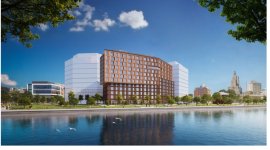This new indoor turf facility and nearly all the other Brown athletic facilities (except Brown Stadium) are located on land that was originally donated with the intent to benefit the poor of Providence. Ebenezer Knight Dexter, a wealthy mercantile trader who died in 1824, bequeathed his 40-acre farm on the East Side of Providence for the construction of a poor farm or almshouse. The Dexter Asylum was thereafter built and opened on the site in 1828. It would eventually include a dormitory living space and several farm buildings.
Dexter's will had specified that Providence could never sell the property and that it could only be used for his specified purpose. The city went to court spending years to eventually get this overturned. It was shortly thereafter sold to Brown in 1956 and converted to athletic purposes. This site, today used by Brown students with many from very wealthy backgrounds, for athletic pursuits is a far cry from what it had been intended for.
The only remnants of the Dexter Asylum that remain today are the large stone walls and gateposts that still encircle the property in various places.
View attachment 58827









